Software That Makes It Easy to Move Files Into Different Folders
The 6 Best Windows File Organization Apps and File Organizer Software
Organizing files on Windows tiring. Let these awesome Windows file organization apps do it for you!
Organizing files on Windows is a tiring job. The only way to overcome it is by putting everything in its place on arrival. Instead of spending valuable time, why not take a smart and lazy approach to file organization.
After all, the better organized your files, the faster you can draw information from them. But how do you get started? We'll take a look at file organization apps and show how you can use them to organize different types of files in Windows automatically.
1. File Juggler
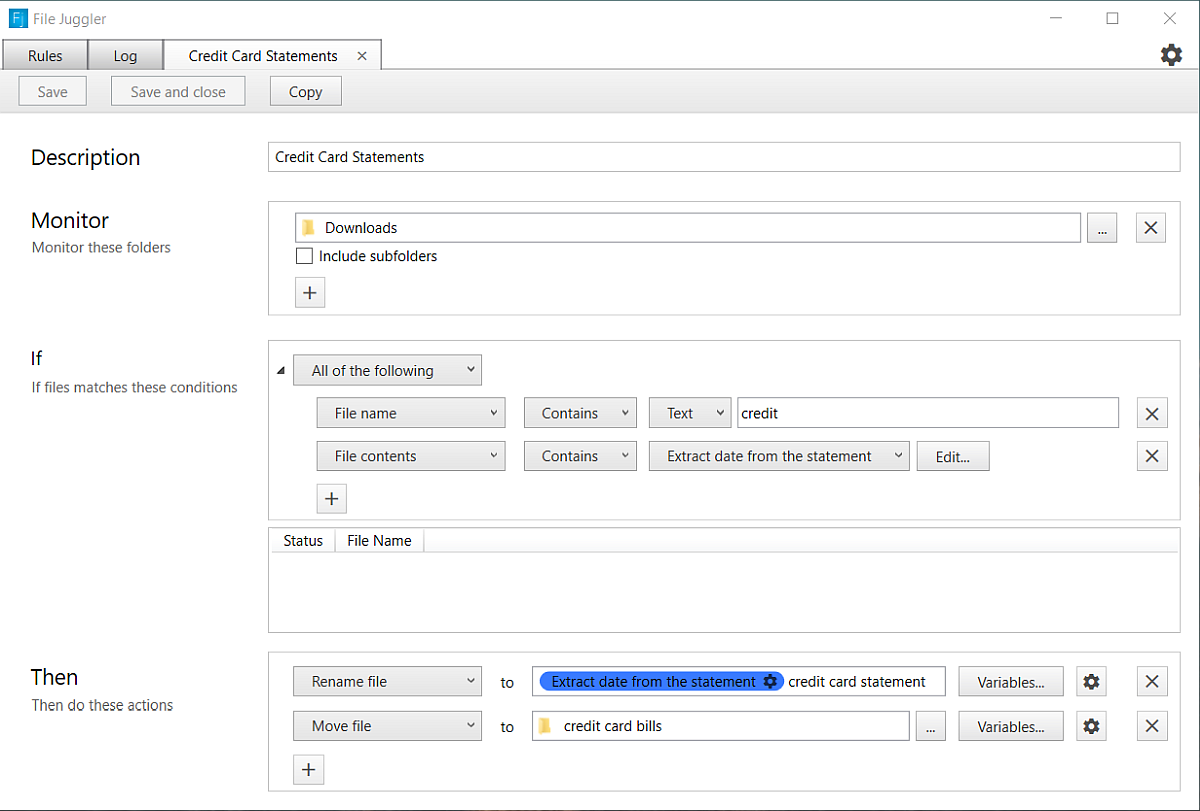
If you're having trouble organizing the files, consider using an automation utility app. File Juggler monitors changes to folders and takes action based on the set of rules. It uses conditional if-and-then statements, just like IFTTT. At first, create a plan on what you want to do with files.
To add a rule, click the Add button and type in a brief description. Add a folder for which you want to take action in the Monitor section. In the If section, add a condition. Check out the conditions page for more information.
Last, choose an action you wish to take on your files in the Then box. You can rename, move, copy, extract, and more.
Unique Features:
- Move and rename files based on the content of a searchable PDF. It works great to organize invoices, credit card bills, and snippets of information.
- You can add variables to organize different types of content with precision. They include file name, path, date, file properties, and more.
- Once your file gets organized, you can tell File juggler to upload a file to Evernote. Select the notebook you want and add tags to the notes.
- A rule can monitor either one or several folders. For each rule, you can check to monitor or exclude the sub-folder as well.
- The Log tab helps you keep track of what your rules have done and whether it's working correctly or not.
Download: FileJuggler (30 days free trial, $40)
2. PhotoMove
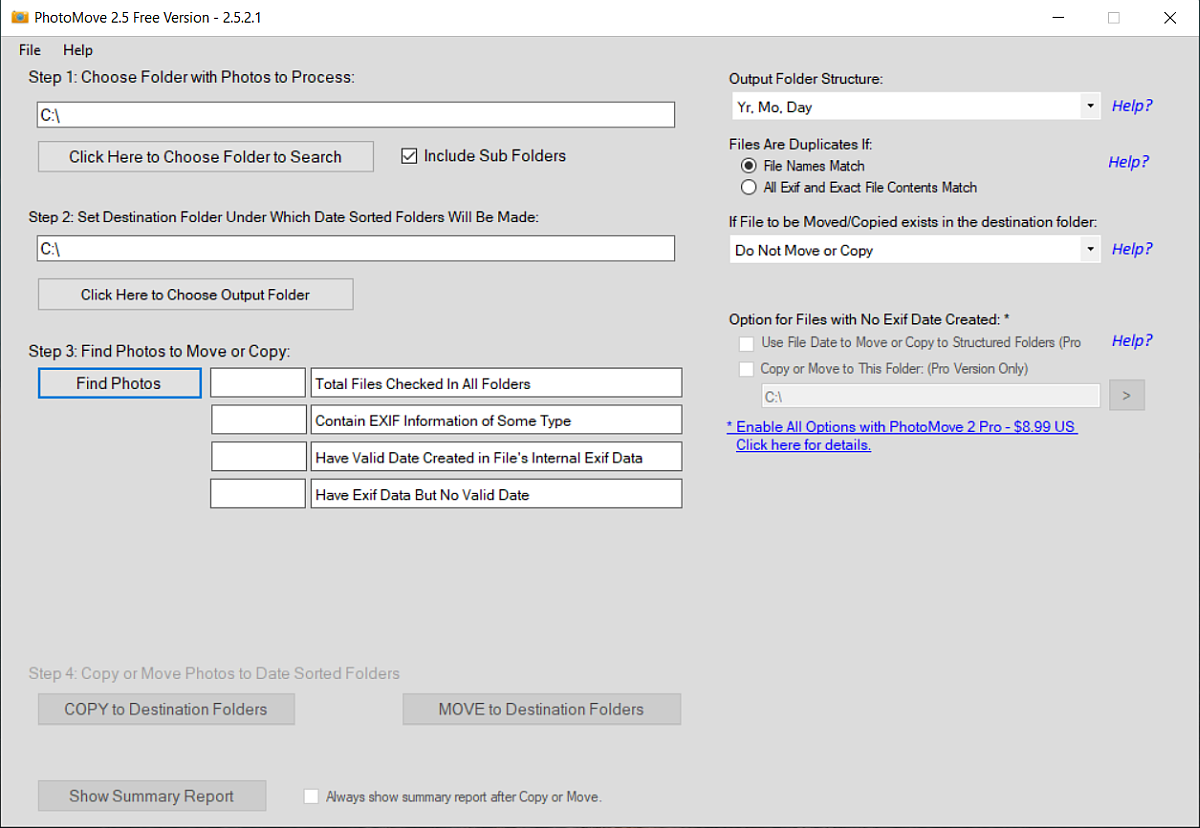
Apps like Adobe Lightroom make it easy to organize images by their EXIF data. If you don't use these kinds of apps, then cataloging and sorting your photos into a folder is a headache. With limited support of metadata, organizing photos in Windows 10 is a manual and tedious task.
PhotoMove uses EXIF data to automatically move (or copy) and sort the photos or videos into folders based on the actual date. Choose the source folder containing your images and the destination folder. Click Find Photos to start a search.
After searching all your photos, click either Move or Copy button to process your files. You can choose to display the summary report if the need arises. The preferences section lets you decide the folder structure, handling duplicate files, file types, and camera models.
Unique Features:
- If you have a vast photo collection, PhotoMove lets you move and sort photos in the Network Attached Storage (NAS). Check the manufacturer updates and SMB version.
- Select different types of folder structure to organize pictures. By default, you can organize photos by Year-Month-Date. The Pro version lets you customize them.
- PhotoMove supports command line syntax. You can use the command prompt or batch file to organize your photo collection.
- If your photos don't have EXIF data, use the file date or sort photos with no EXIF data to a different folder.
Download: PhotoMove (Free, Pro Version: $9)
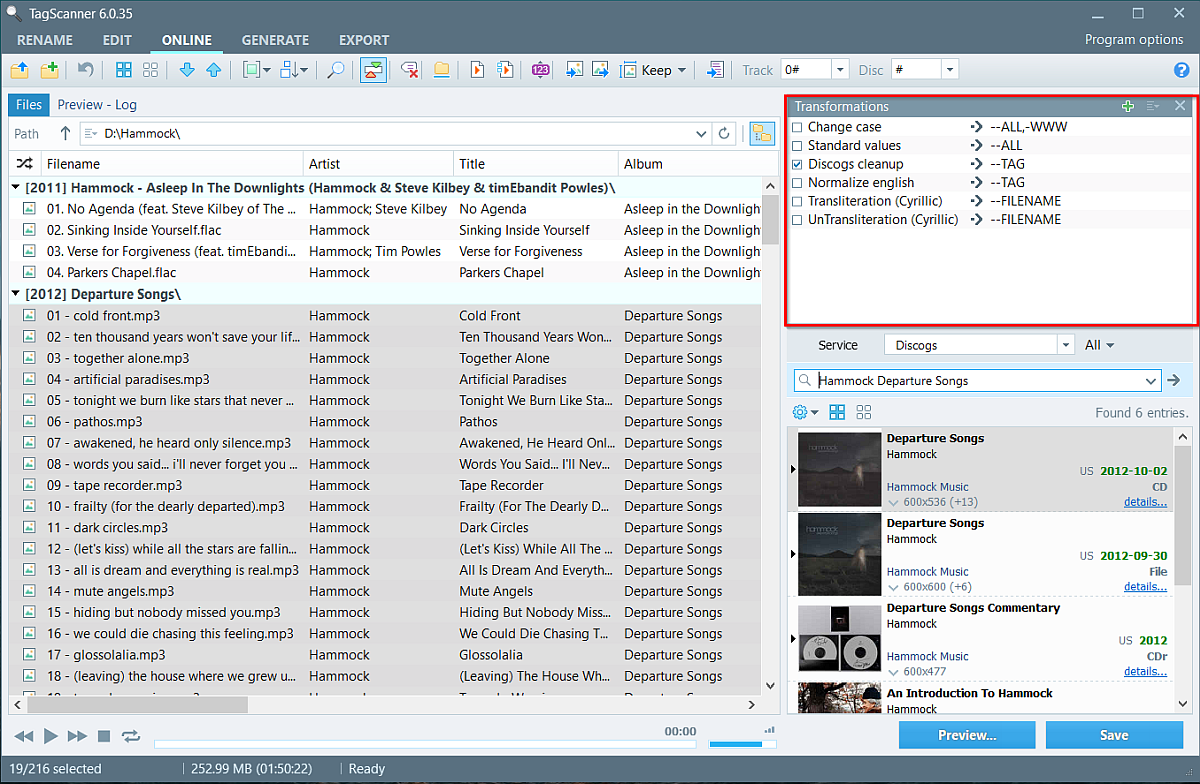
Anyone with a massive collection of music knows the pain of managing a poorly tagged library. While file name is essential, it's the metadata that holds information like artist, album, year of release, cover art, and more. Editing the metadata is a time-consuming and challenging task.
TagScanner is an app that lets you organize and manage music collections. It includes an array of built-in configuration settings for editing tags of audio formats like ID3v1, v2, Vorbis, APEv2, WMA, and iTunes.
Click the Browse for folder button to load the audio files. Within a few moments, the app will read the metadata and display them according to the sorting mode.
Unique Features:
- It supports text replacement and transformation functions. The options include case change, transliteration, FTP compatible names, discog cleanup, and more.
- The built-in scripting engine can do advanced things on the text output. You can append a string function to beautify tags and filenames.
- Rename and organize audio files in bulk. If your music folder is cluttered, you can create a folder structure based on the tag structure.
- Preview tags and cover art from online databases like Freedb, Discogs, Musicbrainz, and Amazon before embedding it into mp3 files.
- You can create playlists and export information as CSV, HTML, M3U, and more.
Download: TagScanner (Free)
4. FileBot
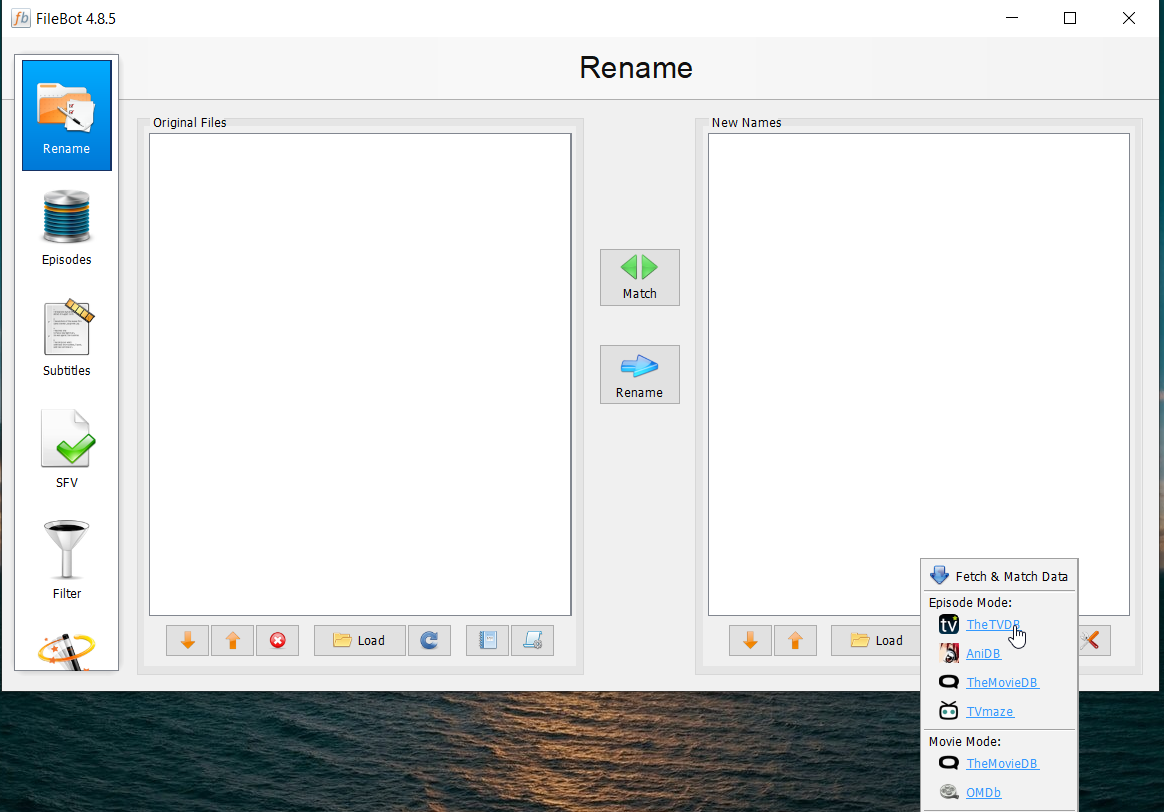
Poorly named files, missing subtitles, episode names, and incomplete information are common problems for people while watching a movie or TV show. FileBot is a utility app that can automate the task of organizing and renaming media files. The app has two panels.
To get started, drag-and-drop the media folder into Original Files panel. Under the New Names panel, click the Fetch Data button.
The app will try to match your files with data from various online databases automatically. They include The TVDB, AnDB, TheMovieDB, and TVmaze. Once you verify the information, click Rename.
Unique Features:
- It can scan the file names to figure out which show, season, and episodes the videos contain. How you choose to name the media files and organize them is up to you.
- It shows you the complete list of every episode a TV series has broadcast. Just search for your show, pick a source, and sorting order.
- Fetching subtitles is a click away. You can manually search and download subtitles, preview, and fix encoding problems.
- Fetch cover art, poster images, and create NFO files for your media library. If you use Kodi, FileBot can fix various metadata-related issues.
- Built-in scripting engine for complex automated processing. With few lines of scripts, you can fetch artwork and details of multiple files.
Download: FileBot (Paid, $6/year)
5. Easy File Organizer
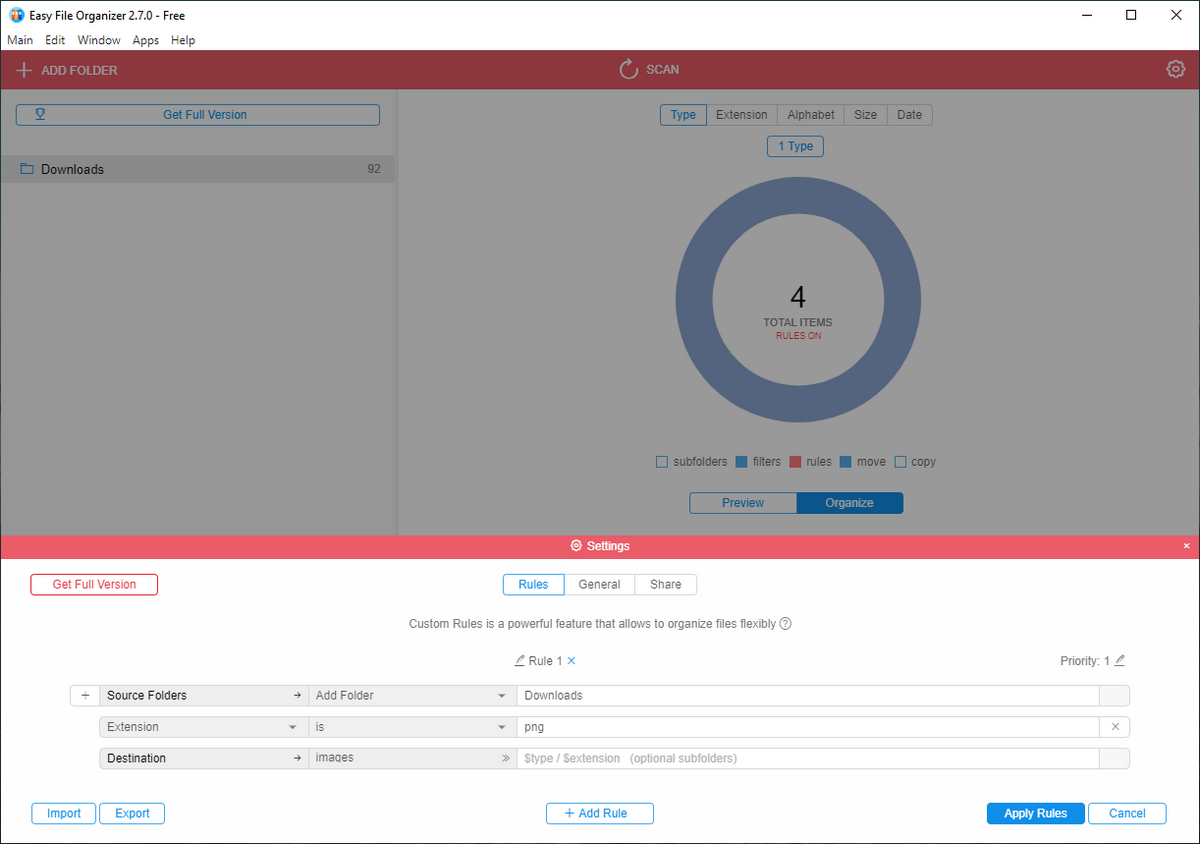
If your desktop and download folder always get cluttered, this utility app will help you end the chaos of unorganized files with a simple click. The app organizes large file collections by re-arranging items according to kind, extension, size, or date.
To get started, add a folder you want to sort out and click Organize. For example, if you select Extension, the app will group files by file extension folders, like pdf, mp3, and more. Similarly, if you choose Date, the app will group files by day, month, or year.
Unique Features:
- You can organize files in folders and their subfolders. Check recursive under the circle graph to get started. Click Undo to revert the changes if you made a mistake.
- Set up custom rules (Settings > Rules) to organize files as per your needs. It is useful when you wish to sort files by other criteria, even if they don't belong to a specific group.
- With templates, you can organize files generated from file names. Go to Settings > Rules and create a template with a number or alphabets.
Download: Easy File Organizer (Free trial up to 30 items, $25)
6. Copywhiz
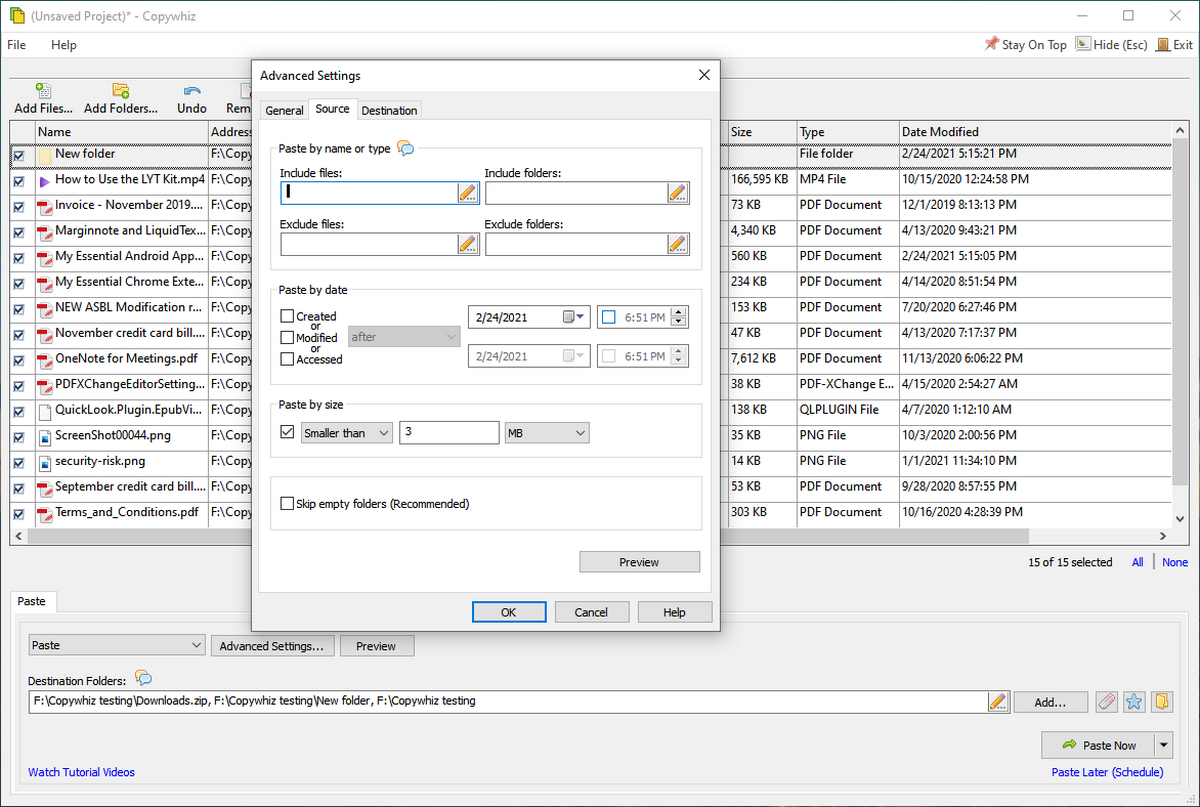
At some point, you must have tried to copy and paste a bunch of files that were in different folders. Having to open multiple windows, then copying your stuff can be confusing and tedious. Copywhiz is a utility app that enhances the file copy experience with the benefits of filtering.
Go to the folder containing your files, right-click and choose Copywhiz > Copy (Add to Queue). Navigate to the destination folder, right-click anywhere and select Copywhiz > Paste Special to decide what you want to do with the files.
Unique Features:
- You can either copy only new or modified files. It saves your time while doing a backup, sharing files with others, or follow a specific workflow every day.
- Copy files based on specific file name, type, extension, and size. This way, you selectively sort out files and organize them.
- Configure the app to copy your files at a particular time. For example, you can save new files grouped date-wise per week on a schedule.
- Pick files from multiple folders and paste them into a folder or zip them all at once. In this way, you'll avoid repeated copy-and-paste operations.
Download: Copywhiz (7-day free trial, $40)
Ideas for Managing Your Files
Organizing files on Windows is a tedious job. If you can spend some time on how to automate it, then it'll save time, and your files won't pile up in the long run.
With the file organizer apps discussed above, you can control the entire file management without putting in much effort.
Source: https://www.makeuseof.com/tag/automatically-organize-files-windows/

0 Response to "Software That Makes It Easy to Move Files Into Different Folders"
Post a Comment